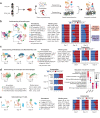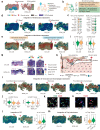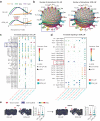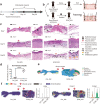Tracing immune cells around biomaterials with spatial anchors during large-scale wound regeneration
- PMID: 37752124
- PMCID: PMC10522601
- DOI: 10.1038/s41467-023-41608-9
Tracing immune cells around biomaterials with spatial anchors during large-scale wound regeneration
Erratum in
-
Author Correction: Tracing immune cells around biomaterials with spatial anchors during large-scale wound regeneration.Nat Commun. 2023 Oct 6;14(1):6240. doi: 10.1038/s41467-023-42118-4. Nat Commun. 2023. PMID: 37803052 Free PMC article. No abstract available.
Abstract
Skin scarring devoid of dermal appendages after severe trauma has unfavorable effects on aesthetic and physiological functions. Here we present a method for large-area wound regeneration using biodegradable aligned extracellular matrix scaffolds. We show that the implantation of these scaffolds accelerates wound coverage and enhances hair follicle neogenesis. We perform multimodal analysis, in combination with single-cell RNA sequencing and spatial transcriptomics, to explore the immune responses around biomaterials, highlighting the potential role of regulatory T cells in mitigating tissue fibrous by suppressing excessive type 2 inflammation. We find that immunodeficient mice lacking mature T lymphocytes show the typical characteristic of tissue fibrous driven by type 2 macrophage inflammation, validating the potential therapeutic effect of the adaptive immune system activated by biomaterials. These findings contribute to our understanding of the coordination of immune systems in wound regeneration and facilitate the design of immunoregulatory biomaterials in the future.
© 2023. Springer Nature Limited.
Conflict of interest statement
The authors declare no competing interests.
Figures







References
-
- Willyard C. Unlocking the secrets of scar-free skin healing. Nature. 2018;563:S86–s88. - PubMed
Publication types
MeSH terms
Substances
LinkOut - more resources
Full Text Sources

